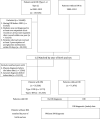Prevalence and risk factors for myopia in Taiwanese diabetes mellitus patients: a multicenter case-control study in Taiwan
- PMID: 33854140
- PMCID: PMC8046800
- DOI: 10.1038/s41598-021-87499-y
Prevalence and risk factors for myopia in Taiwanese diabetes mellitus patients: a multicenter case-control study in Taiwan
Abstract
This population-based retrospective cohort study investigated the prevalence of myopia among patients with Type 1 and Type 2 diabetes mellitus (DM) and evaluate risk factors for myopia in these groups. Records from 2000 to 2012 with at least one year of follow-up from the Taiwan National Health Insurance Research Database were included. This study included 35,538 patients with DM and 71,076 patients without DM. Patients with DM had a significantly higher adjusted hazard ratio for myopia in all age groups and both sexes compared with patients without DM. The subgroup analysis results revealed that the rates of myopia and astigmatism were significantly higher among patients with DM compared with patients without DM aged < 60 years. However, the rates of high myopia or myopia progression to high myopia did not differ significantly between the two groups. These findings indicate that DM is a critical risk factor for myopia and astigmatism among patients aged < 60 years. Therefore, active surveillance and earlier treatment of myopia are critical for patients with DM.
Conflict of interest statement
The authors declare no competing interests.
Figures



References
Publication types
MeSH terms
LinkOut - more resources
Full Text Sources
Other Literature Sources
Medical

